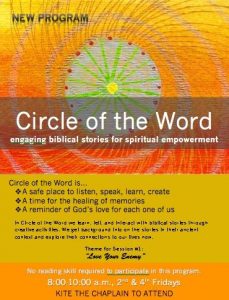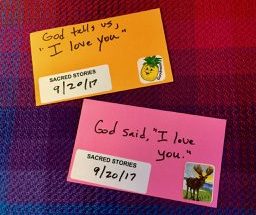 Last fall I read that, while the incarceration rate for men has stabilized in recent years, women’s incarceration has skyrocketed. I also read about the impact on children when mothers are incarcerated—how it is much more drastic than with fathers (though both are devastating).
Last fall I read that, while the incarceration rate for men has stabilized in recent years, women’s incarceration has skyrocketed. I also read about the impact on children when mothers are incarcerated—how it is much more drastic than with fathers (though both are devastating).
Put together those facts with the fact that my church has a team of women doing a Circle of the Word with women in the jail, and that we have a women’s prison right here in Dayton, suddenly it seemed like a no-brainer to explore starting a Circle there, at least that’s the message I heard when I asked God for guidance. So come January of this year I did.
At first it seemed like it might not work out for lack of time and space in DCI to start another program. Plus, I got the impression the chaplain wasn’t so sure about what I was proposing. I understand the hesitancy. It’s her job to vet programs. Especially religious programs.
From what I’ve heard from other chaplains, church people coming into jails and prisons aren’t necessarily bringing something positive for the inmates. Sometimes they just inflict more punishment on folk who are already experiencing punishment. As the chaplain at our county jail said,
“A lot of times the leaders of a Bible study or worship service can come off as self righteous or judgmental and beat them over the head about their decision-making. You don’t have to tell an inmate that they’re wrong. They know they’re wrong, they’re in jail.”
But she did give me a green light. She also gave me a different perspective on team development, which I took to God in prayer. Instead of looking for team members from other churches in the District, I decided to see if I could recruit them from Grace United Methodist Church, where people are familiar with biblical storytelling and accepting of the notion of relating to people behind bars.
Grace is also my primary base of ministry so the task of teamwork would be easier. Since I’m going on faith that I can manage this new program when I already am struggling to keep up with everything, that was an important piece of the discernment.
I asked our pastor and a lay leader for recommendations. The top two on our list both said yes. Praise God! That was a good sign.
So by February the team was in place, and by March we had a time slot. At the chaplain’s request I created a flyer that could be posted around the DCI campus (pictured above). We filled out all the paperwork for applying to volunteer as required by the Ohio Department of Rehabilitation and Correction.
Then we waited. I had sent mine in first and its approval came within a couple of weeks. It was a couple of months before Elaine and Hope got theirs. Patience is one of the things you have to learn when ministering in a prison context, though I can’t say I succeeded. I have since learned that volunteer approval can take much longer. Big bureaucracy, understaffed.
We decided on a start date of June 9. In late May I called to see how many women had signed up to come, if any. The chaplain said twenty. Holy Cow! I’ve never done a circle with more than sixteen, and twelve is the max I put on it in the jail. Again, the chaplain gave me a new perspective, and I had to re-think things. I decided to cap it at twenty-four and have two Circles.
Our first series is called “Love Your Enemies.” The series starts with a teaching story from Jesus’ Sermon on the Mount in Matthew, then continues with a story from each of the other three Gospels about Jesus practicing what he preaches: doing acts of love to people from enemy groups.
It’s the same series as we’re doing in the jail, but there we go every week for nine weeks so we spend two or three weeks on each story. In the prison we go every other week so we’ll do a different story each time. The stories we’re doing from Mark, Luke, and John are The Syro-Phoenecian Woman, The Centurion’s Slave, and The Samaritan Woman.
The week before our start date the chaplain said that twenty-four had signed up, and she had a waiting list. Holy COW! I’ll write about what happened another time.




